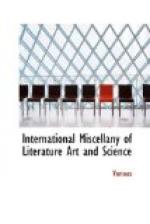But this object failing, they returned to England,
and took up their abode at Twickenham, on the banks
of the Thames. In Great Britain they were treated
with respect and consideration, and were furnished
with ample opportunities for repose after their exciting
adventures. Within a few years, however, the Duke
of Montpensier and the Count Beaujolais both died—the
former in England, the latter at Malta. Louis
Philippe had accompanied his last surviving brother
to that island, and after his interment sailed for
Sicily, on the invitation of the King of Naples.
There he gained the affections of the Princess Amelia,
and their marriage took place in November, 1809.
No event of material importance marks the subsequent
life of the Duke, until the year 1814, when, on the
abdication of Napoleon, he returned to Paris, and
for a short period was in full enjoyment of his honors.
In 1815, Napoleon’s escape from Elba again called
the Duke of Orleans into active employment, and he
proceeded, in obedience to the desire of Louis XVIII.,
to take the command of the Army of the North.
In this situation he remained until the 24th of March,
hen he surrendered his command to the Duke de Treviso,
and retired to Twickenham. After the Hundred Days,
the Duke of Orleans obeyed the ordinance authorizing
the Princes of the blood to take their seats in the
Chamber of Peers; but subsequently incurring the jealousy
and displeasure of the Court, he resought his old residence
on the Thames, and dwelt there in seclusion until 1817,
when he went back to France, and devoted himself to
the education of his children, until the Revolution
of 1830 broke out, resulting in his elevation to the
throne. The subsequent events of his reign, and
the memorable outbreak of 1848, that finally overthrew
the dynasty that the monarch had strained every nerve
to establish, are too fresh on the public mind to require
recapitulation here.
* * * *
*
JOHN INMAN.
John Inman, a son of William Inman, was born in Utica
in 1805. He had two brothers, William, a commander
in the Navy, and Henry, so well known as one of the
finest artists of this country. John Inman was
educated pretty much by chance; he had the usual country
schooling; but whatever valuable cultivation he had
was in after-life when he was alone in the world,
seeking his fortune. In 1823 he went to North
Carolina where he taught school for two years.
In the spring of 1826, with the profits of his schoolmastership,
he went to Europe, and traveled there a little more
than a year. On his return, being admitted to
the bar, he practiced law about two years, when, in
1829, he became one of the editors of The Standard
newspaper, which he left in 1830 to conduct the Mirror.
In 1833 he was married to Miss Fisher, a sister of
the popular and estimable actress, Clara Fisher, and
about this time he devoted the leisure left from the




